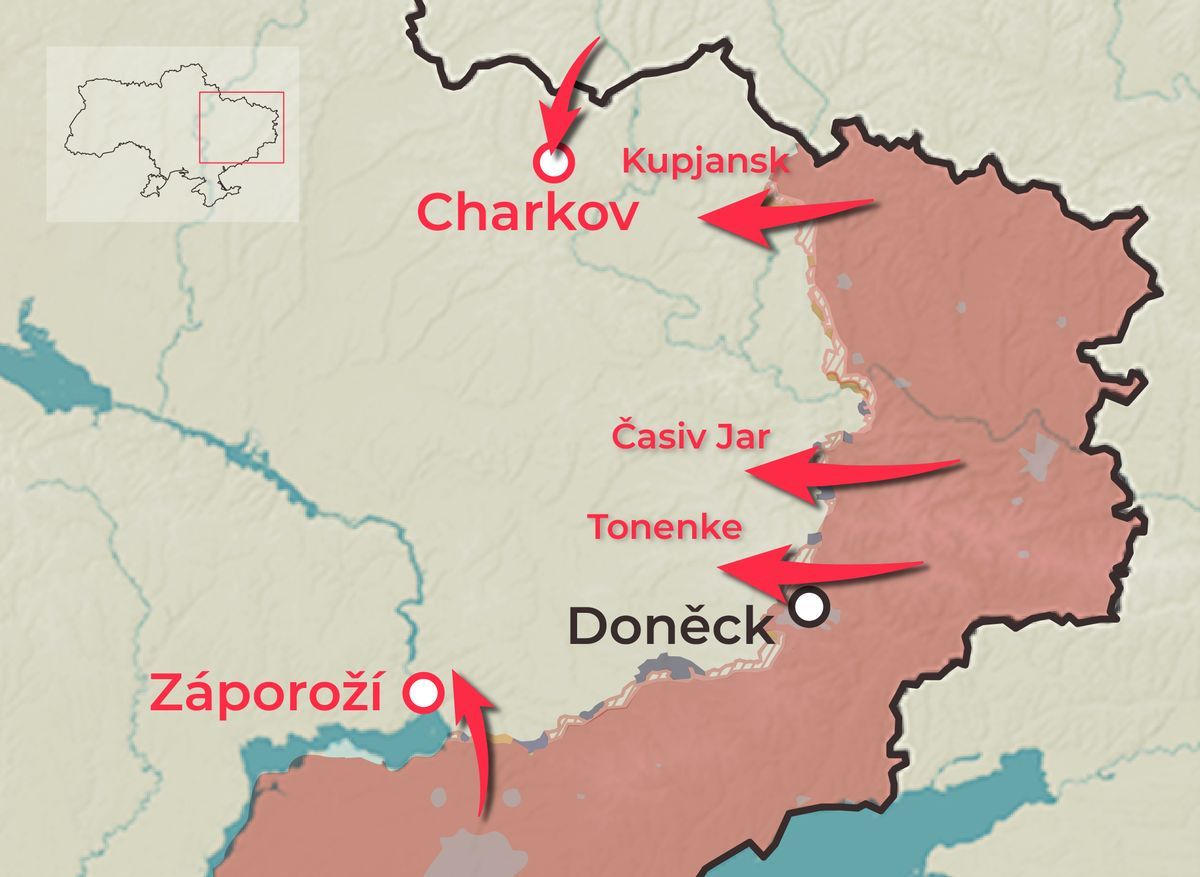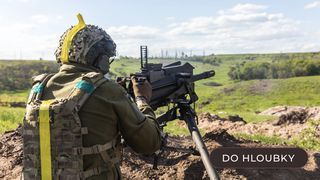We will begin our review of the battlefield with a brief mention of the air war. Both sides continued to strike far in the rear. Ukrainian drones with success, the extent of which we do not know, https://twitter.com/wartranslated/status/1783031856495038963 to other Russian refineries. Russian drones and missiles continued to destroy Ukrainian energy, for example in the Odesa region.
If we were to evaluate the success of both campaigns, the Russian one is expected to have a greater impact on the adversary than the Ukrainian one. Ukraine’s fossil fuel power plants were badly damaged by the attacks, and so was the country https://twitter.com/UkrainianEnergy/status/1781296689086701903 electricity from the European Union.
Attacks by Ukrainian drones have such a visible effect on Russian fuel production, above all https://twitter.com/SergeyVakulenk0/status/1781026013301920032, so far they haven’t, although refineries are clearly struggling and output fell to an 11-month low last week. We will see how the situation develops further.
On the front line
Now let’s move on to the ground fighting. Their intensity was quite high, both according to the testimony from the front and the numbers by the Ukrainian side https://twitter.com/ragnarbjartur/status/1783042468214157823.
As usual, we will start the description of the situation from the north. In the Luhansk region, there was relatively intense fighting around Kreminna, for example, but the Russian attackers did not manage to make any confirmed progress. Ukrainian forces are not attempting any offensive operations in the current situation, so the front has not moved despite losses on both sides.
As usual, the center of gravity of the fighting lay mainly in the Donetsk region. In today’s text, we will stop at three points on this line, although of course the fighting took place in other places as well.
As usual, it will be in a north-south direction, so the first stop will be the town of Časiv Jar above Bakhmut. Here Russian troops are trying to build strong positions for an attack on the city itself. This is because the area is crossed by a freshwater channel, which creates an artificial barrier and a good defensive line.
In the meantime, Russian troops are gradually making their way up towards Chasiv Yar, seizing strongholds in the area to gather forces for the attack. Events take place both directly towards the city and also north and south of the city. Thus, a bypass could occur, forcing the defenders to withdraw from a well-situated city on higher ground.
Turtle tanks on the battlefield
Several examples of the Russian “turtle tank” have appeared on the battlefield, a machine equipped with a strange metal cover that covers the entire vehicle like a carapace. Apparently, this is another attempt to protect against drone attacks.
It is not at all clear whether this Russian plan will succeed. The Russian command has tried something similar in Ukraine many times: sometimes with success and sometimes the opposite. There is nothing unpredictable about the tactics themselves. The goal is to gradually exhaust the defender and find a weak point. If this fails, the Russians may abandon the direction of attack after a while and try to look for a weakness elsewhere. Or pounding the same spots for weeks or months at a time. Only the future will tell.
However, there are certain reasons to doubt the strength of the Ukrainian defense. The 67th brigade, which was in charge of defense, was withdrawn from the city. It was not a planned replacement, it was said to be the result of problems in the unit. It is the last volunteer-founded brigade in the Ukrainian army whose command was associated with the Ukrainian nationalist right.
People in command reportedly had difficulty with the demands of the new commander of the Ukrainian Armed Forces, General Syrsky, who consistently sought to “unify” the structure of the Ukrainian forces. According to the newspaper Ukrainska Pravda, they took it as “persecution”.
In addition, the unit allegedly had a habit of assigning all new recruits to selected sections, which often ended up in the front line. Some of them were unable to maintain their position at Časiv Jar even in a situation where it was expected of them. As a result, the 67th brigade was detached from the front and “will undergo reorganization”, which will most likely mean a change of people at its head.
The 241st Brigade took its place. It may not have similar problems, but it is not a mechanized brigade, but a militia unit. This means that, at least on paper, it should not have as much equipment and heavy weapons as a mechanized brigade. The Ukrainian command can understandably compensate for this with reinforcements, for example in the form of special artillery units. If, of course, he has them available.
Despite the exchange of units, the situation at Časiv Jar has not fundamentally changed. Northwest of Avdijivka, around and in the village of Očeretyne, however, a similar event led to quite dramatic changes.
Confusion and penetration
It all started around April 19 and 20, when two units were to be replaced in the section around Ocheretyne: the Ukrainian 47th Mechanized Brigade was to be replaced by the 115th Brigade. This is always a sensitive moment when units are vulnerable. First, they have to get out of cover, secondly, rookies often don’t know the terrain well and don’t have their defenses that well prepared.
The Russian detachments sometime before, or in those days, should have found two places where the Ukrainian minefields were not deep enough, or they were very sparse.
Between April 20 and 21, Russian forces took advantage of this. They launched a sudden attack on the Ukrainian 115th mechanized brigade from Stepovy, advanced about four kilometers, seized the Ocheretyne railway station and pushed the Ukrainian reserves back.
It is unclear whether some Ukrainian troops retreated from their positions without orders, or whether the Russians simply seized an opportunity. In any case, a narrow corridor was created that penetrated several kilometers into Ukrainian positions. The Russian command sent them more and more men – of which they have enough – to consolidate the positions and hold them against the expected counterattack.
Photo: DeepState (https://deepstatemap.live/)
The queue around Ocheretyne according to Ukrainian mappers from the DeepState project as of April 24, 2024.
The Ukrainian command took a quite logical step: the 47th brigade had to turn around and go back to the front. Thanks to this, it was possible to stop further Russian advance towards the west, at least for a while.
But it was only a temporary respite. The Russian attacks continued and it seems that Ocheretyne is almost or completely in Russian hands. The Russians can use this to turn the attack to the south, for example, and bypass the Ukrainian defense around Berdych.
The situation for Ukraine is still not good, it is not stabilized and further retreat can be expected. Material and quantitative superiority is on the Russian side. The Russians have been consistently launching airstrikes and shelling Ukrainian positions with heavy artillery in key areas.
Although Ukrainian FPV drones are carrying out strikes on infantry and Russian supply of forward positions, this was not enough to break the link and weaken the Russian line. There is not enough artillery ammunition, the Ukrainian air force has no chance against the Russian air force. And since there is also a lack of ammunition for anti-aircraft defense, Russian aircraft no longer have to rely only on strikes with glide bombs, but increasingly machines (planes and helicopters) appear in the immediate vicinity of the front line.
So, if the information available at the moment is true, there was no collapse at Ocheretyne that would signal a fundamental change in the morale of the Ukrainian troops, as some early reports suggested. But the situation showed well the relative strength of both sides at the current moment.
The Russians have the upper hand in practically every aspect. They have more men, more ammunition and more heavy weapons, including effective air support. The Ukrainian command, on the other hand, only has a minimum of reserves, because the country’s political command postponed mobilization, and it is faced with a lack of practically all material, perhaps with the exception of FPV drones.
The situation won’t just change. Even if Ukraine starts mobilizing now, the new soldiers will not reach the front for several months. Deliveries of the newly pledged American aid will come gradually; it is hard to imagine that the Ukrainian army would suddenly have enough of everything.
Where is the main Russian attack expected?

Photo: Institute for the Study of War, List of Reports
Map showing the most discussed possible directions and objectives of the Russian offensive.
Show all
Novomikhajlivka
The occupying forces also succeeded completely https://twitter.com/moklasen/status/1782490216327946726 from the village of Novomichajlivka, which is located several tens of kilometers southwest of Avdijivka and Donetsk. In this direction, Russian forces are trying to push the defense of the city of Vuhledar, which has been the target of unsuccessful attacks since last winter.
Russian forces have been attacking the village intensively since around October last year. They showered it with aerial bombs, artillery and launched a series of attacks on it by larger or smaller mechanized columns carrying infantry.
Even by the standards of the Ukrainian battlefield, the offensive was quite “expensive” for the Russian army. We do not know the number of killed and wounded, the Russian army apparently lost around 300 pieces of equipment in the village and its surroundings. (Ukrainian 79th Brigade three hundred destroyed pieces of Russian equipment is evidenced by video footage and https://twitter.com/AndrewPerpetua/status/1775813958709973086 is also reported by independent volunteers analyzing the available video documentation.)
What will the new Russian offensive look like?
Will there be a change in tactics and a Russian attempt to make a deep and quick breakthrough, or will the crumbling of the Ukrainian defense “only” intensify? Five analysts lean more towards the second option. One way or another, Ukraine risks losing a lot.

The fact is, however, that the Russian command and, apparently, the majority of Russian society are prepared for similar losses and are willing to tolerate them. This may seem hard to understand from a Western perspective, but as analyst Michael Kofman recently noted, Russia relates its war loss expectations to World War II, not modern Gulf War conflicts like Western militaries. From this point of view, the losses in Ukraine are relatively low (with a big emphasis on the word relatively).
There were no significant changes or events in other parts of the front. On the southern front, Russian forces have apparently pushed the defenders out of part of the village of Robotyne, but they will not hold on to it permanently. The Russians also made several other fruitless raids on the Ukrainian bridgehead near the village of Krynky across the Dnieper in the Kherson region.









